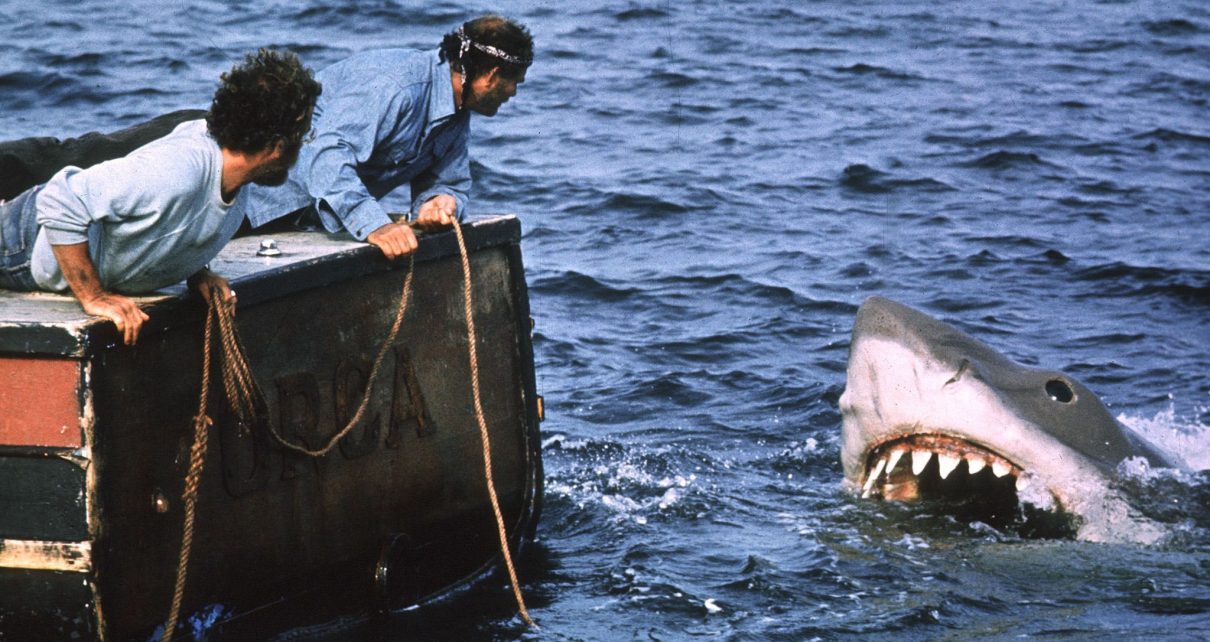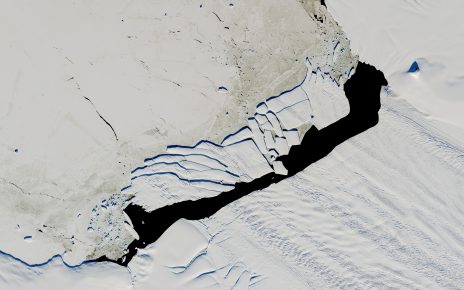The blockbuster film Jaws has been a perennial favorite here on Martha’s Vineyard since its release 45 years ago. The epic 1975 feature film, shot on the Vineyard in iconic places like the picturesque fishing village of Menemsha, pits a fictional seaside tourist town called Amity against a villainous great white shark whose fearsome triangular teeth—300 of them—bite and kill unsuspecting townspeople and summer visitors enjoying the local Atlantic Ocean waters. Jaws played recently at a COVID-safe drive-in theater here, allowing viewers to scream in the privacy of their own cars.
The movie took a deep dive into the psyche of audiences—and ocean swimmers—creating a larger-than-life fictional movie monster that evoked perpetual fear of the great white shark. However, the Jaws phenomenon also triggered admiration and awe of these magnificent marine animals in the wild, as well as a push for more scientific field research into their natural history.
Studies in recent decades have sought to demystify the demon shark in Jaws and to create a more nuanced view of this apex predator atop the marine food chain: white sharks eat seals, sea lions, dolphins, porpoises and many types of fish—but humans are not part of their normal diet. Ironically, the human threat to sharks is far greater than the shark threat to humans. Each year, fishermen kill, directly or indirectly, an estimated 100 million sharks of all kinds worldwide, the majority for shark fin soup or meat. Many deaths also occur after white sharks are snagged in commercial fishing gear.
Jaws author Peter Benchley later regretted the man-eating portrayal of the fictional white shark in his best-selling book and the more dramatic, bloodthirsty depiction in the Oscar-winning Steven Spielberg film. With his wife Wendy, he became an avid conservationist, working with environmental groups and research scientists on behalf of oceans and sharks everywhere until his untimely death in 2006.
“When Jaws came out, it was a scary movie that terrified a lot of people,” said Wendy Benchley. “Peter would not have written it the way he did once he knew more about sharks,” she said. “He wrote it with the knowledge he had at the time. It was a first novel, not a scientific treatise.”
“The book and film exaggerated the white shark’s behavior. The white shark in the film was far larger than normal—about 25 feet—while the largest animals in the wild are typically 15 to 18 feet,” says Greg Skomal, a fisheries biologist and well-known shark expert with the Massachusetts Division of Marine Fisheries. “They had it satisfying hunger by consuming humans. They don’t do that. White sharks did not evolve with humans as prey or food,” he said. “The Jaws shark even seemed vindictive, attacking the boat and going after the captain. White sharks certainly don’t do that. It became this epic battle between the shark and the people chasing after it.”
When Jaws came out, “relatively little was known about the white shark. We know a lot more now about white shark ecology, distribution and natural history,” says Skomal. Studies of the white shark species, Carcharodon carcharias, show its critical role in keeping the marine ecosystem in balance, exerting top-down forces on the food web that help hold other ocean species in check.
In the Atlantic Ocean waters off New England, shark attacks on humans are “incredibly rare events,” says Skomal, especially when compared to other water dangers, like riptides and boating accidents. “Many more people drown than are attacked by sharks,” he said.
Nonetheless, when attacks do occur, they draw incredible publicity. In July, a wetsuit-wearing 63-year-old woman swimming in the chilly Gulf of Maine waters was killed by a great white shark—the first such death in Maine’s history. In September 2018, a 26-year-old man boogie boarding off Massachusetts’ Cape Cod was killed by a shark, the first shark attack fatality in the state since 1936.
Worldwide, there were 105 confirmed shark attacks on humans in 2019, including five deaths, according to the International Shark Attack File, based at the Florida Museum of Natural History. It documented 64 unprovoked attacks on humans worldwide, significantly lower than the five-year average of 82 incidents annually. The U.S. leads the world in unprovoked shark attacks, with 41 in 2019. Of those, Florida had the most, with 21, followed by Hawaii with nine. In New England, the only 2019 fatality occurred in Rhode Island. The Shark Attack File also documented 41 provoked attacks globally in 2019 in which humans “initiated interaction with a white shark in some way.”
Although shark attacks are few in number and relatively stable year over year, white sharks in Atlantic coastal waters appear to have increased in number. “From the best available data, it appears that white sharks on the Eastern seaboard of the U.S. are rebounding after years of heavy exploitation,” said Skomal. Populations went down in the 1970s and 1980s with the expansion of commercial and recreational fishing that targeted big fish. But federal conservation regulations, starting in the 1990’s, provided strong protections for white sharks from fishing.
White sharks feed on seals, which have been protected since 1972 by the federal Marine Mammal Protection Act. Seal populations have also grown in number in Atlantic coastal waters, with higher densities in Massachusetts off Cape Cod and the Gulf of Maine in summer and fall months. “That provides a forage base that has drawn white sharks closer to shore,” said Skomal.
One sign of sharks in the vicinity is the presence of seals they may be following for food.
“Don’t swim where there is a high density of seals,” says Skomal. He advises swimmers to stay in shallower water, avoid turgid waters, or swimming when it is dark or getting dark. Some scientists say the sharks are more active at dawn or dusk, he said.
The Massachusetts Division of Marine Fisheries, working with the Atlantic White Shark Conservancy, has tagged more than 220 white sharks with acoustic or satellite-based tracking devices. Acoustic tagging has led recently to novel protection for Cape Cod beachgoers. At selected beaches, lifeguards armed with acoustic receivers can track in real time the proximity of tagged white sharks nearby, says Skomal, leading to temporary beach closures to swimming as needed. To promote safety and awareness of white sharks, the conservancy, which is based in Cape Cod, also has a popular app called Sharktivity, developed with state and local officials, that provides alerts about sightings of white sharks in the Cape Cod area.
Using satellite-based tagging technology to study seasonal migration patterns of white sharks in the western Atlantic, Skomal and colleagues have shown the animals are more widely distributed than previously thought. “They were thought to be largely coastal in nature. But we’ve discovered them in the open ocean diving to depths as deep as 3,000 feet,” says Skomal.
In the summer and early fall, white sharks are found in coastal waters as far north as Newfoundland, moving south for the late fall, winter and spring months to coastal waters off the southeastern U.S., from North Carolina to the Gulf of Mexico. Working with researchers from the Woods Hole Oceanographic Institution and Massachusetts Institute of Technology, Skomal found that during this time some white sharks also head further out into deeper waters of the open Atlantic, going as far east as the Azores. In a 2017 paper in the Marine Ecology Progress Series, the scientists noted that “our findings extend the known essential habitat for the white shark in the North Atlantic beyond existing protection, with implications for future conservation.”
“We now have relatively robust white shark populations on both coasts” of the U.S. and in “hot spots” around the world, said marine conservation biologist Austin Gallagher, chief executive and lead scientist at Beneath the Waves, a nonprofit research and conservation organization. “We need to find ways of coexisting with them,” he said, including educating the general public about the natural history of the white shark and how best to avoid encounters with it. According to the International Shark Attack File, about half of shark attacks on humans are related to surfing or board sports, with one fourth involving swimmers or waders. Its Web page provides additional safety advice for reducing the risk of shark bites.
Jaws was an important motivator for many people to go into marine science. “Jaws inspired me to do what I’m doing today. I thought the Jaws marine biologist Matt Hooper had a great job. I was always fascinated by sharks and the ocean,” says Skomal. “It’s an entertaining film to this day.”
Gallagher, who was not alive when Jaws premiered in 1975, saw the film when he was about eight years old. “Jaws is one of my favorite movies,” he says. “I look back on it as a motivating factor for pursuing a career as a scientist. A lot of us saw ourselves as Matt Hooper.”
“People, and especially children, are fascinated with sharks,” said Wendy Benchley, who continues to promote ocean conservation through speaking, writing and serving on the boards of nonprofits like Beneath the Waves and WildAid. She’s beginning to think about special events celebrating the 50th anniversary of Jaws as a way to increase public awareness of marine environmental issues, from plastic pollution to overfishing. “People need to be more aware that the ocean is in deep trouble,” she said.
As for Jaws, the beautifully written thriller and heart-pumping film hold up well for today’s audiences. It’s worth rereading or seeing it again—I just did—and appreciating it as a popular work of fiction that magnifies the power of the great white shark. The suspenseful opening scenes of the movie—with that pounding, fear-inducing music—feature a young woman hopping into the ocean water for a nude midnight swim and, yes, right into the jaws of a menacing great white shark. Okay. You can scream now. Or feel a little squeamish when her bloody remains are found washed up on shore.
If you’ve never read or seen Jaws, where have you been? And what are you waiting for? It’s time for a shot of adrenaline. But see the film’s man-eating shark monster for what it is: a fictional characterization in a seaside scary movie, not a portrait of the great white shark’s behavior in nature.




